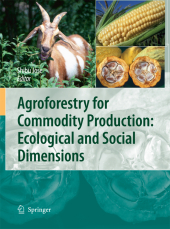 Neuerscheinungen 2014Stand: 2020-02-01 |
Schnellsuche
ISBN/Stichwort/Autor
|
Herderstraße 10
10625 Berlin
Tel.: 030 315 714 16
Fax 030 315 714 14
info@buchspektrum.de |

Shibu Jose
Agroforestry for Commodity Production: Ecological and Social Dimensions
Herausgegeben von Jose, Shibu
2010. 2014. vi, 247 S. 260 mm
Verlag/Jahr: SPRINGER NETHERLANDS; SPRINGER 2014
ISBN: 9400791119 (9400791119)
Neue ISBN: 978-9400791114 (9789400791114)
Preis und Lieferzeit: Bitte klicken
In addition to addressing the biophysical and socioeconomic dimensions of producing traditional food, fodder and fiber crops, this volume examines the potential to integrate biomass crops, botanicals and ornamental plants into agroforestry practices.
Agroforestry systems have been touted as sustainable production systems that alleviate many of the environmental problems associated with modern production systems. Are they indeed ecologically and economically sustainable? Using case studies from around the globe, this book highlights the potential of agroforestry systems to produce a broad range of commodities. In addition to addressing the biophysical and socioeconomic dimensions of producing traditional food, fodder and fiber crops, this volume examines the potential to integrate biomass crops, botanicals and ornamental plants into agroforestry practices. The book should be particularly useful to students, professionals, researchers and policy makers involved in natural resource management, agroforestry, and environmental management.
1. Interactions amongst trees and crops in taungya systems of western Kenya; Moses Imo.- 2. Active root distribution pattern of Hevea brasiliensis determined by radioassay of latex serum; Sherin George et al.- 3. Production physiology of three native shrubs intercropped in a young longleaf line plantation; Donald L. Hagan et al.- 4. Dry matter partitions and specific leaf weight of soybean change with tree competition in an intercropping system; Ameur M. Manceur et al.- 5. Natural abundance of 15N in two cacao plantations with legume and non-legume shade trees; Pekka Nygren, Humberto A. Leblanc.- 6. Soil phosphorus and water effects on growth, nutrient and carbohydrate concentrations, d13C, and nodulation of mimosa (Albizia julibrissin Durz.) on a highly weathered soil; Adrian Ares et al.- 7. Silvopastoralism in New Zealand: review of effects of evergreen and deciduous trees on pasture dynamics; Raquel Benavides et al.- 8. Pasture production under densely planted young willow and poplar in a silvopastoral system; Z. Hussain et al.- 9. Relationship between tree canopy height and the production of pasture species in a silvopastoral system based on alder trees; Naba R. Devkota et al.- 10. Changes in limiting resources determine spatio-temporal variability in tree-grass interactions; G. Gea-Izquierdo et al.- 11. Are drought and wildfires turning Mediterranean cork oak forests into persistent shrublands?; Vanda Acácio et al.- 12. Allelopathic effects of Eucalyptus urophylla on ten tree species in south China; Bizhen Fang et al.- 13. Scaling-up productivity (NPP) using light or water use efficiencies (LUE, WUE) from a two-layer tropical plantation; Olivier Roupsard et al.- 14. Modeling cotton production response to shading in a pecan alleycropping system using CROPGRO; Diomides S. Zamora et al.- 15. Transitioning from wild collection toforest cultivation of indigenous medicinal forest plants in eastern North America is constrained by lack of profitability; Eric P. Burkhart, Michael G. Jacobson.- 16. Coppicing improved fallows are profitable for maize production in striga infested soils of western Kenya; Abednego Kiwia et al.- 17. Adoption potential of selected organic resources for improving soil fertility in the central highlands of Kenya; Jayne Mugwe et al.- 18. Current situation and prospects of Jatropha curcas as a multipurpose tree in China; Meng Ye et al.- 19. Complementary labor opportunities in Indonesian pulpwood plantations with implications for land use; Romain Pirard, Judith Mayer.


